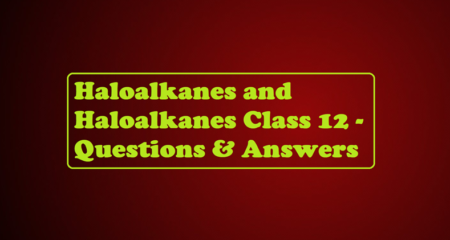Amines NEET Questions
Amines NEET Questions
Que 1. Which of the following are 10 amines?
(a) Ethylenediamine
(b) Dimethylamine
(c) Trimethylamine
(d) N-methyl aniline
Ans 1. (a) Ethylene diamine (NH2 – CH2 – CH2 – NH2)
Que 2. C3H9N represents
(a) Primary amine
(b) Secondary amine
(c) Tertiary amine
(d) All of these
Ans 2. (d) All of these
Explanation: CH3CH2CH2 – NH2 → 10
CH3CH2NHCH2 → 20
CH3N(CH3)2 → 30
Que 3. In the nitration of benzene using a mixture of Conc. H2SO4 and conc. HNO3 the species which initiates the reaction is:
(a) NO2
(b) NO+
(c) NO2+
(d) NO2–2
Ans 3. (c) NO2+
Explanation: https://www.youtube.com/watch?v=Affk1mMeRis
Que 4. The correct IUPAC name of CH2 = CH — CH2NHCH3 is:
(a) Allymethyl amine
(b) 2-amino-4-pentene
(c) 4-aminopent-lene
(d) N-methylprop-2-en-amine
Ans 4. (d) N-methylprop-2-en-amine
Que 5. Which of the following reactions is appropriate for converting acetamide to methanamine?
(a) Hoffmann bromamide reaction
(b) Stephen’s reaction
(c) Gabriel phthalimide synthesis
(d) Carbylamine reaction
Ans 5. (a) Hoffmann bromamide reaction
Explanation:

Amines NEET Questions
Que 6. The method by which aniline cannot be prepared is
(a) Degradation of benzamide with bromine in alkaline solution
(b) Reduction of nitrobenzene with H2/Pd in ethanol
(c) Potassium salt of phthalimide treated with chlorobenzene followed by hydrolysis with aqueous NaOH solution
(d) Hydrolysis of phenyl isocyanide with an acidic solution.
Ans 6. (c). The potassium salt of phthalimide treated with chlorobenzene followed by hydrolysis with aqueous NaOH solution
Explanation: Aniline cannot be prepared by this method because aryl halides do not undergo nucleophilic substitution reaction with potassium phthalimide under mild conditions.
Que 7. Amides may be converted into amines by reaction named after
(a) Perkin
(b) Claisen
(c) Hoffmann
(d) Kolbe
Ans 7. (c) Hoffmann
Explanation: CH3 – CO – NH2 + Br2 + 4KOH → CH3NH2 + K2CO3 + KBr + H2O
Que 8. Reaction CH3CONH2 ——NaOBr—→ gives
(a) CH3Br
(b) CH4
(c) CH3COBr
(d) CH3NH2
Ans 8. (d) CH3NH2
Explanation: CH3CONH2 ——NaOBr—→ CH3NH2
Que 9. Which is the weakest base:

Ans 9. (a)
Que 10. The correct order of basic strength for the following compounds is:

(a) ii < iii < i
(b) iii < i < ii
(c) iii < ii < i
(d) ii < i < iii
Ans 10. (d) ii < i < iii
Explanation: Lewis base is capable to furnish its electron pair. In nitroaniline, the electron-withdrawing effect of -NO2 results in the non-availability of lone pair electrons available with nitrogen, so it is the least basic.
Que 11. Acetamide is treated with the following reagents separately. Which one of these would yield methylamine?
(a) NaOH-Br2
(b) Soda lime
(c) Hot conc. H2SO4
(d) PCl5
Ans 11. (a) NaOH-Br2
Explanation: CH3 – CO – NH2 + Br2 + 4NaOH → CH3NH2 + Na2CO3 + NaBr + H2O
Que 12. Which one of the following on reduction with lithium aluminium hydride yields a secondary amine?
(a) Methyl isocyanide
(b) Acetamide
(c) Methyl cyanide
(d) Nitroethane
Ans 12. (a) Methyl isocyanide
Explanation: Alkyl isocyanide on reduction with lithium aluminium hydride forms secondary amine-containing methyl as one of the alkyl groups.

Que 13. Primary and secondary amines are distinguished by
(a) Br2/KOH
(b) HClO4
(c) HNO2
(d) NH3
Ans 13. (c) HNO2
Que 14. The decreasing order of the basic character of the three amines and ammonia is
(a) NH3 > CH3NH2 > C2H5NH2 > C6H5NH2
(b) C2H5NH2 > CH3NH2 > NH3 > C6H5NH2
(c) C6H5NH2 > C2H5NH2 > CH3NH2 > NH3
(d) CH3NH2 > C2H5NH2 > C6H5NH2 > NH3
Ans 14. (b) C2H5NH2 > CH3NH2 > NH3 > C6H5NH2
Que 15. Considering the basic strength of amines in an aqueous solution which one has the smallest pKb value?
(a) (CH3)2NH
(b) C6H5NH2
(c) CH3NH2
(d) (CH3)3N
Ans 15. (a) (CH3)2NH
Que 16. In which of the following amines, the first has a lower pKb value than the second
(a) aniline, m-nitroaniline
(b) m-Toluidine, p-toluidine
(c) aniline, p-chloroaniline
(d) aniline, p-aminophenol
Ans 16. (a) aniline, m-nitroaniline , (c) aniline, p-chloroaniline
Que 17. Aniline is reacted with bromine water and the resulting product is treated with an aqueous solution of sodium nitrite in presence of dilute hydrochloric acid. The compound so formed is converted into tetrafluoroborate which is subsequently heated to dry. The final product is
(a) p-bromoaniline
(b) p-bromofluorobenzene
(c) 1, 3, 5-tribromobenzene
(d) 2, 4, 6-tribromofluorobenzene.
Ans 17. (d) 2, 4, 6-tribromofluorobenzene.
Que 18. A given nitrogen-containing aromatic compound ‘A’ reacts with Sn/HCl, followed by HNO2 to give an unstable compound ‘B’. ‘B’, on treatment with phenol, forms a beautiful coloured compound ‘C’ with the molecular formula C12H10N2O. The structure of compound ‘A’ is

Ans 18. (d)

Amines NEET Questions



